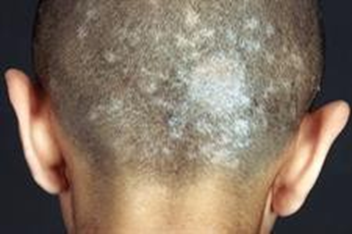A school nurse is assessing a school-age child and notices white flakes that don't brush off the hair and a rash on the back of the child's neck. The nurse should suspect which of the following disorders?
Pediculosis capitis
Impetigo contagiosa
Folliculitis
Tinea capitis
The Correct Answer is D
A. Pediculosis capitis, commonly known as head lice, is characterized by the presence of live lice and nits (lice eggs) attached to the hair shaft close to the scalp. They do not typically cause a rash on the back of the neck.
B. Impetigo is a bacterial skin infection characterized by red sores or blisters that rupture and form honey-colored crusts. It commonly affects areas of the body with broken skin, such as the face, hands, and arms.
C. Folliculitis is inflammation or infection of the hair follicles caused by bacteria or fungi. It can result in red, swollen, and pus-filled bumps around hair follicles.
D. Tinea capitis is a fungal infection of the scalp and hair follicles. It is characterized by the presence of white or grayish flakes that adhere to the hair shafts and cannot be easily brushed off, along with a rash or scaly patch on the scalp. The rash may extend to the back of the neck.

Nursing Test Bank
Naxlex Comprehensive Predictor Exams
Related Questions
Correct Answer is B
Explanation
A. Release of sodium bicarbonate from renal compensation: In response to metabolic acidosis, the kidneys may attempt to compensate by excreting hydrogen ions and retaining bicarbonate ions. However, this mechanism does not contribute to the development of diabetic ketoacidosis.
B. Diabetic ketoacidosis (DKA) is a serious complication of diabetes mellitus, particularly type 1 diabetes, resulting from a relative or absolute deficiency of insulin. In the absence of sufficient insulin, the body cannot properly utilize glucose for energy, leading to increased lipolysis (breakdown of fat) and subsequent production of ketone bodies (such as acetone, acetoacetate, and beta-hydroxybutyrate) as an alternative fuel source. The accumulation of ketone bodies in the blood lowers the blood pH, leading to metabolic acidosis characteristic of DKA.
C. Excretion of excess potassium from cellular death: Diabetic ketoacidosis can lead to electrolyte imbalances, including hyperkalemia due to shifts of potassium out of cells as acidosis worsens. However, this is a consequence of DKA rather than a primary cause.
D. In type 1 diabetes mellitus, there is an absolute deficiency of insulin, leading to hyperglycemia. Elevated glucose levels contribute to the osmotic diuresis seen in DKA, but they are not the primary cause of ketoacidosis.
Correct Answer is ["A","B","C","D"]
Explanation
These findings indicate that the child is experiencing significant pain, which is concerning, especially considering the history of sickle cell anemia and the recent increase in pain despite previous management with acetaminophen. Chest pain could also be indicative of a vaso-occlusive crisis or a respiratory complication.
Nasal flaring and moderate subcostal and substernal retractions are noted:
Nasal flaring and retractions suggest increased work of breathing, which could indicate respiratory distress. In a child with sickle cell anemia, respiratory complications like acute chest syndrome are a significant concern during a vaso-occlusive crisis.
Bilateral, moderate inspiratory and expiratory wheezes noted upon auscultation:
Wheezing indicates airway obstruction or inflammation, which could be due to asthma exacerbation, infection, or acute chest syndrome, all of which are common complications in children with sickle cell disease.
Whether you are a student looking to ace your exams or a practicing nurse seeking to enhance your expertise , our nursing education contents will empower you with the confidence and competence to make a difference in the lives of patients and become a respected leader in the healthcare field.
Visit Naxlex, invest in your future and unlock endless possibilities with our unparalleled nursing education contents today
Report Wrong Answer on the Current Question
Do you disagree with the answer? If yes, what is your expected answer? Explain.
Kindly be descriptive with the issue you are facing.
